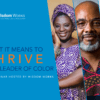A third of your day. That’s how much time you may be spending in meetings, by some estimates. Worse, in a survey reported in Industry Week 2,000 managers said that they thought a third of that time in meetings was wasted. OUCH! Popular economist John Kenneth Galbraith has even said, “Meetings are indispensable when you don’t want to do anything.” OUCH again! Instead of a meeting being a time and place to increase creativity, enthusiasm, productivity, and wellbeing, for many of us they are an energy-depleting time sink.
But they don’t have to be.
With a few simple tweaks meetings can be efficient, energizing, and a great way to show a commitment to wellbeing. Here’s how.
1. Have an agenda with clear objectives and stick to it. Effective leaders know that clarity—in vision, plans, and, yes, even in meetings—helps prevent confusion and anxiety. An agenda designed around well-defined objectives keeps a meeting from getting sloppy and descending into chaos. It simply helps participants know how to prepare themselves for the meeting and be aware of what’s going to happen next. They feel more relaxed and more prepared to tackle the topics at hand. (Leaving a meeting without being clear about what just happened or what is supposed to happen next is definitely a wellbeing-buster.)
2. Keep it short. Forget those 60-minute minutes that have people racing from one meeting to another (and to the restroom) at the top of the hour. The longer the meeting, the more often people will lose focus (and the will to live, if you believe this humorous chart). So give back 10-15 minutes and schedule a shorter meeting with a tight agenda. Everyone will be more focused and will appreciate the time to check email or to take the long route to their next meeting (increasing their wellbeing along with their number of steps!).
3. Walk the meeting. I’ve said it so many times that I’m starting to harp: Our bodies are not made to sit all day, and that includes in meetings. Yet our workplaces often are unwittingly built to keep people stationary. Change that by turning every meeting—with your team or one-on-ones—into a walking opportunity. Moving your body brings amazing productivity benefits: your brain works better, you have more energy, and you feel more emotionally balanced. And, new research shows, walking can boost creativity!
4. Set a positive tone from the get-go. We all know that positive attitudes create better outcomes. So why not use your meeting to make happiness and optimism a habit? As ideas, you could kick off the meeting by having everyone jot down three things they are grateful for (“my kids,” “my health”). Or have each person briefly (I emphasize: briefly) tell the group one thing they admire about the person to his or her right (“her amazing poise,” “his dry wit,” “the way she pitches in”). Watch your meeting-goers start smiling and the meeting energy rise.
5. Change the scenery. If meetings are small or one-on-one, print out your agenda and meet outside or at a nearby coffee house. Senior Vice President Scott Pann and his colleagues at the financial institution UBS often trek to Buttercup, a nearby yogurt shop, for team meetings. They’ve dubbed it “Meeting Room B.” The walk and the change in environment never fail to invigorate them, Pann says.
6. Put wellbeing on the agenda. Particularly if your meeting is over 45 minutes, schedule a stretch break and make sure the purpose of the wellbeing break is clear: “We’re stretching for three minutes at 10:30 to get our bodies moving after the brainstorm part of our meeting. This should work out the kinks and clear our heads to help us knock off the rest of our agenda so we can all leave on time.”
READ MORE
• 3 Reasons Leaders Should Listen to Pharrell Williams’ ‘Happy’
• Are You Walking the Wellbeing Talk?
• 3 Leaders Who Rock Earth Day All Year Long
Photo Credit: Adam Jones, PhD (some rights reserved)






